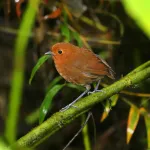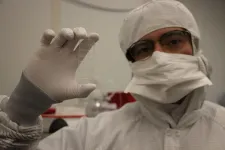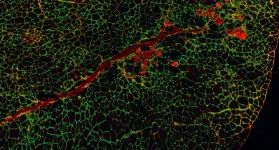(Press-News.org) How many species of birds are there in the world? It depends on whose count you go by. The number could be as low as 10,000 or as high as 18,000. It's tough to standardize lists of species because the concept of a "species" itself is a little bit fuzzy.
That matters because conserving biodiversity requires knowing what diversity exists in the first place. So biologists, led by University of Utah doctoral candidate Monte Neate-Clegg of the School of Biological Sciences, set out to compare four main lists of bird species worldwide to find out how the lists differ--and why. They found that although the lists agree on most birds, disagreements in some regions of the world could mean that some species are missed by conservation ecologists.
"Species are more than just a name," Neate-Clegg says. "They are functional units in complex ecosystems that need to be preserved. We need to recognize true diversity in order to conserve it."
The results are published in Global Ecology and Biogeography.
On the origin of species
The definition of a species isn't clear-cut. Some scientists define populations as different species if they're reproductively isolated from each other and unable to interbreed. Others use physical features to delineate species, while yet others use genetics. Using the genetic definition produces many more species, but regardless of the method, gray areas persist.
"Species are fuzzy because speciation as a process is fuzzy," Neate-Clegg says. "It's a gradual process so it's very difficult to draw a line and say 'this is two species' vs. 'this is one species.'"
Also, he says, physical features and genetic signatures don't always diverge on the same timescale. "For example," he says, "two bird populations may diverge in song and appearance before genetic divergence; conversely, identical populations on different islands may be separated genetically by millions of years."
Comparing the lists
At this point in the story, it's time to introduce four lists, each of which purports to include all the bird species in the world. They are:
The Howard and Moore Checklist of the Birds of the World
The eBird/Clements Checklist of Birds of the World
The BirdLife International Checklist of the Birds of the World
The International Ornithological Community (IOC) World Bird List
"Being active field ornithologists who are always trying to ID bird species means that one is always faced with the issue of some species being on one list but not the other," says Çağan Şekercioğlu, associate professor in the School of Biological Sciences. "So our field experience very much primed us to think about this question and inspired us to write this paper."
The lists have different strengths depending on their application. The BirdLife International list, for example, integrates with the IUCN Red List, which reports on species' conservation status. The IOC list is updated by experts twice a year, Şekercioğlu says. The list is open access with comparisons to other major lists, and changes are documented transparently.
"But as a birdwatcher, I use eBird all the time, which uses the Clements checklist, and that dataset is very powerful in its own right," Neate-Clegg says. "So there is no single best option."
One example of the disagreement between lists might be the common bird Colaptes auratus. The eBird list calls it the northern flicker, a woodpecker. But the BirdLife International list delineates the eastern population as the yellow-shafted flicker and the western population as the red-shafted flicker.
In 2020, Neate-Clegg and his colleagues read a study that compared the raptor species on each list, finding that only 68% of species were consistent among all four lists.
"We thought it would be interesting to investigate taxonomic agreement for all 11,000 bird species," Neate-Clegg says. "More importantly, we wanted to try and work out what species characteristics led to more or less taxonomic confusion."
They began by collecting the most recent version of each list (the IOC checklist is updated biannually, the researchers write, and the Clements and BirdLife lists annually, while Howard and Moore has not been updated since 2014) and trimming them down to exclude subspecies and any extinct species. Using a few other data processing rules, they assigned a single name to every possible species across all four lists. Then the comparisons began.
Where the lists agree and disagree
The researchers found that the four lists agreed on the vast majority of bird species--89.5%. For the remaining 10.5%, then, they started to look for patterns that might explain the disagreement. Some of it was likely geographical. Birds from the well-studied Northern Hemisphere were more likely to find agreement than birds from the relatively understudied Southeast Asia and the Southern Ocean.
Some of it was habitat-based. Agreement was higher for large, migratory species in relatively open habitats.
"I think the most surprising result was that agreement was not lower for highly forest-dependent species," Neate-Clegg says. "We expected these denizens of the rainforest floor to be the most cryptic and hard to study, with more uncertainty on their taxonomic relationships. Yet we found it was actually species of intermediate forest dependency that had lower taxonomic agreement. We believe that these species move about just enough to diverge, but not so much that their gene pools are constantly mixing."
And part of the issue with species classification on isolated islands, such as those in Southeast Asia and the Southern Ocean, was a phenomenon called "cryptic diversification." Although islands can foster species diversification because of their isolation, sometimes two populations on different islands can appear very similar, even though their genes suggest that they've been isolated from each other for millions of years. So, depending on the definition, two populations could count as two species or as only one.
"In addition," Neate-Clegg says, "it's very hard to test the traditional biological species concept on island fauna because we cannot know whether two populations can interbreed to produce fertile young if they are geographically isolated."
Why it matters
So what if some people disagree on species designations? Conservation actions are usually on the species level, Neate-Clegg says.
"If a population on one island goes extinct, people may care less if it's 'just a subspecies,'" he says. "And yet that island is potentially losing a functionally unique population. If it was recognized as a full species it might not have been lost."
Neate-Clegg hopes the study points ornithologists towards the groups of species that merit additional attention.
"We also want conservation biologists to recognize that cryptic diversity may be overlooked," he adds, "and that we should consider units of conservation above and below the species level."
INFORMATION:
Find the full study here.
A new analysis of lung epithelial cells from COVID-19 patients reveals how the protective complement branch of the immune system, which usually plays roles in both innate and adaptive immunity, can convert to a harmful system during COVID-19. Blocking excessive complement activity in lung epithelial cells with a combination of existing chemotherapy and antiviral medications - ruxolitinib and remdesivir, respectively - helped normalize the production of complement proteins by infected lung epithelial cells in human cell culture experiments, the researchers found. Thus, the drug duo could serve as a promising strategy to treat damaging inflammation during severe COVID-19, the authors say. Overactivation of complement proteins can contribute to diseases such as acute respiratory distress ...
HERSHEY, Pa.-- Social distancing and lockdowns may have reduced the spread of COVID-19, but researchers from Penn State College of Medicine also report those actions may have affected clinical researchers' ability to finish trials. Study completion rates dropped worldwide between 13% and 23%, depending on the type of research sponsor and geographic location, between April and October 2020.
Researchers previously reported that more than 80% of clinical trials suspended between March 1 and April 26, 2020, noted the pandemic as their chief reason for halting activity. Patient enrollment in studies was lower in April 2020, compared to April ...
WYOMISSING, Pa. -- Teaching people to become entrepreneurs requires more than just passing on entrepreneurial skills, according to a team of Penn State Berks-led researchers. Would-be entrepreneurs also need to understand -- and negotiate -- the barriers that they might face.
In a study, researchers built a multidimensional model to measure the effectiveness of entrepreneurship education. The model not only includes teaching entrepreneurial skills, but also addresses the students' intentions to start a business and their perceptions of the barriers they might encounter when starting a business.
"There are a lot of studies in the literature that focus on, for example, how entrepreneurship education ...
HOUSTON -- (April 7, 2021) -- Rice University computer scientists have demonstrated artificial intelligence (AI) software that runs on commodity processors and trains deep neural networks 15 times faster than platforms based on graphics processors.
"The cost of training is the actual bottleneck in AI," said Anshumali Shrivastava, an assistant professor of computer science at Rice's Brown School of Engineering. "Companies are spending millions of dollars a week just to train and fine-tune their AI workloads."
Shrivastava and collaborators from Rice and Intel will present research that addresses that bottleneck April 8 at the machine learning systems conference MLSys.
Deep neural networks ...
In an article published in the April 8 issue of Nature, the National Institutes of Health's Somatic Cell Gene Editing Consortium provided a detailed update on the progress of their nationwide effort to develop safer and more effective methods to edit the genomes of disease-relevant somatic cells and reduce the burden of disease caused by genetic changes.
Gene editing allows scientists to modify sections of an organism's DNA and is considered a promising treatment for a number of genetic diseases. There have been numerous advances in the laboratory over the last few decades, but there are still many challenges to overcome before gene editing can be widely used in the patient population. Launched in 2018, the Somatic Cell Gene Editing Consortium ...
A natural brilliant blue coloring has been discovered by an international team of researchers including chemists at the University of California, Davis. The new cyan blue, obtained from red cabbage, could be an alternative to synthetic blue food colorings such as the widely used FD&C Blue No. 1. The work is published April 7 in Science Advances.
"Blue colors are really quite rare in nature - a lot of them are really reds and purples," said Pamela Denish, a graduate student working with Professor Justin Siegel at the UC Davis Department of Chemistry and Innovation Institute for Food and Health.
Having ...
Scientists have developed a long-sought naturally derived cyan blue colorant sourced from red cabbage anthocyanin pigments that may offer an alternative to the industry standard blue dye, although more testing is needed to determine the compound's safety. The novel colorant, which was developed using an enzyme that converts a range of anthocyanins to one with the ideal wavelength, remains highly stable over time and may also produce better green colors than those derived from existing natural blue colorants. Several research programs around the world are dedicated to the hunt for a natural alternative to FD&C Blue No.1 - a challenging effort given that cyan blue is one of the rarest colors in nature. While previous research has shown that ...
DURHAM, N.C. -- An interdisciplinary team of scientists at Duke University has developed a highly sensitive and rapid diagnostic test for Ebola virus (EBOV) infection. In monkeys infected with Ebola, this diagnostic, called the D4-assay, proved to be 1000 times more sensitive than the currently approved rapid diagnostic test and capable of detecting the virus a full day earlier than the gold standard polymerase chain reaction (PCR) test.
This work, which appears in Science Translational Medicine on April 7, was done by biomedical engineers, molecular ...
Progression of Duchenne Muscle Dystrophy (DMD) can be delayed in mice by supplementing their diets with Urolithin A, according to new results reported today. The findings, published in Science Translational Medicine, raise hopes that new treatment options could one-day be developed for DMD, an uncurable genetic condition characterized by progressive muscle degeneration. About 1 in 3,500 boys are born with DMD, which usually develops in childhood and significantly reduces life expectancy.
The new research carried out at the laboratory of Professor Johan Auwerx, ...
The lungs were for a long time considered to be sterile in health, while in diseases like chronic obstructive pulmonary disease (COPD) failure in immune mechanisms were thought to allow microorganisms to proliferate and persist. New sequencing techniques have shown that several microorganisms reside in the lungs of healthy individuals, as well. Few studies have examined the fungal community in COPD and compared it to healthy controls using such techniques. According to the study findings, the compositions of these environments seem to be unaffected by the use of inhaled steroids.
Lungs have a unique fungal environment
The Bergen COPD Microbiome study (short name "MicroCOPD") is the world's largest single-centre study on the fungal community in ...



